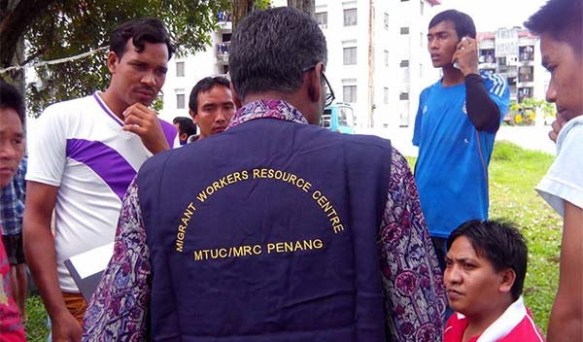
Ben Harkins, Technical Officer for the ILO Tripartite Action to Protect the Rights of Migrant Workers in the Greater Mekong Subregion
Khin Su, 22, used to work at a factory on the outskirts of Bangkok. Like many other migrants from Myanmar, she came to Thailand with her husband in search of a better life. But their aspirations soured one day in 2012 when her hand was trapped under a faulty hydraulic press, severing four of her fingers.
To make matters worse, Khin Su didn’t have a work permit, which meant she wasn’t eligible to receive disability benefits from the Government. With only her husband to provide for their family, the future looked uncertain.
In search of assistance, she went to a migrant worker resource center (MRC) run by the Thai Trade Union Congress with support from the ILO. With the help she found there, and a great deal of courage and perseverance, Khin Su was eventually able to obtain financial compensation and get her family back on their feet.
Today, she works informally as a paralegal so that she can help other migrants who find themselves in the same situation.
I know Khin Su because, as a researcher with the ILO GMS Triangle Project, it’s my job to understand whether the services we offer are really helping people. The project has provided counseling and legal support to over 60,000 migrant workers in the Greater Mekong Subregion and Malaysia.

What I wanted to know was: are those services really helping to protect migrant workers’ rights? Are migrants better able to access justice as a result?
Attempts to answer questions like this have usually boiled down to what you might call “bean counting” the outputs: the number of workers provided with services, the number of authorities trained and so on.
While that does have value, it can’t tell you whether the outputs are having their intended effect—at least, not without making some pretty big assumptions. You can think of it like playing darts while blindfolded. You know you threw the darts, but you can’t be sure that they hit the target.
The reason this approach is so common is because getting evidence from migrants, months or years after they’ve received assistance, can be very hard to do. Migrants are inherently mobile, they often work in informal or isolated circumstances and lack of legal documents and fear of reprisals can make them wary about revealing their situation to strangers.
Nevertheless, if we want to understand how best to protect their rights, we clearly need information from migrant workers themselves. Understanding that it would be hard to get this directly, we decided to work through our implementing partners, who’d spent years building up trust with migrant communities.
We knew that their capacity to carry out monitoring and evaluation varied considerably and that ensuring the quality of data we needed would take training. We also knew that the subject is often seen as complex and esoteric, so we’d need a practical approach.

Instead of organising a large formal training, we decided to hold tailored seminars with 23 different partners to provide coaching specific to their areas of work. This allowed each to receive support that was as relevant as possible to the services they were offering. We found this approach led to high levels of engagement among participants, very lively discussions and lots of active roleplay. At the risk of sounding biased, I’d say the sessions were even fun.
We’re still a long way from fully understanding the best ways to help migrant workers in all situations. But several months after these training sessions, we have much better data to work with. And what it tells us so far is pretty encouraging.
A follow-up survey of 1,500 migrant workers who received counseling from MRCs revealed that they were more likely to migrate through regular channels and felt that their rights were better protected as a result. Moreover, we found that the migrants assisted with complaints had been awarded over US$2 million in compensation for a broad range of abuses, from lack of overtime pay to cases of forced labour.
Following analysis of lessons learned from this work, we have shared our approach to contribute to an expanded knowledge base among practitioners. Much of the methodology has been disseminated in manuals and handbooks for operating MRCs and documented in forthcoming publications, including a comprehensive global review of safe migration projects.
